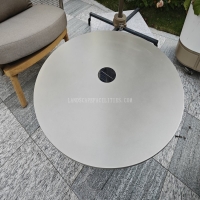Welcome to the website for landscape facilities products and knowledge.
How does the market for landscape bar counters differ between residential and hospitality sectors?
The market for landscape bar counters reveals fascinating divergences between residential and hospitality applications, driven by fundamentally different usage patterns, design priorities, and operational requirements. While both sectors embrace these elongated, often statement-making fixtures, their implementation reflects distinct market dynamics.
In residential settings, landscape bar counters serve as multifunctional lifestyle enhancers. Homeowners prioritize aesthetic integration with living spaces, often treating the bar as a secondary entertaining area or a casual dining alternative. Material selections lean toward premium, visually warm surfaces like quartz with veining, polished concrete, or high-end woods that complement domestic interiors. Functionality focuses on storage for personal collections, undercounter refrigeration for household use, and ergonomic seating for family members. The residential market values customization and uniqueness, with clients seeking one-of-a-piece designs that reflect personal taste rather than commercial durability.
Conversely, the hospitality sector approaches landscape bars as high-performance workstations and revenue generators. Hotel lobbies, restaurants, and bars prioritize operational efficiency, durability, and customer experience above purely aesthetic concerns. Commercial-grade materials dominate – stainless steel components, impervious solid surfaces, and heavily laminated woods that withstand constant use and intensive cleaning. The design emphasizes workflow optimization with dedicated zones for preparation, service, and payment processing. Hospitality bars incorporate robust plumbing, commercial refrigeration, and specialized storage for inventory management. Seating density becomes a calculated decision based on turnover rates and revenue per square foot.
The manufacturing and supply chain differ substantially between markets. Residential projects typically involve custom cabinet makers and high-end kitchen specialists working on single units with longer lead times. The hospitality industry relies on specialized commercial outfitters who provide standardized, code-compliant solutions for chain establishments or large-scale projects, often with quicker turnaround requirements.
Market drivers also vary significantly. Residential demand connects to housing trends, renovation cycles, and disposable income levels, with homeowners viewing bars as luxury additions. Hospitality investment ties directly to consumer spending on entertainment, tourism trends, and beverage industry profitability, where bars represent calculated business investments with clear ROI expectations.
Ultimately, while the physical form may appear similar, landscape bar counters represent entirely different value propositions across sectors. Residential units symbolize lifestyle and personal expression, while commercial installations serve as engineered solutions for profit generation – a fundamental distinction that shapes every aspect of their design, specification, and market positioning.
Related search:

Recommendation
Outdoor stainless steel table with solar-powered ambient lighting feature - excellent design.